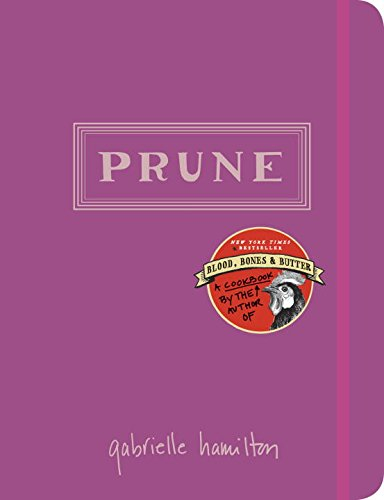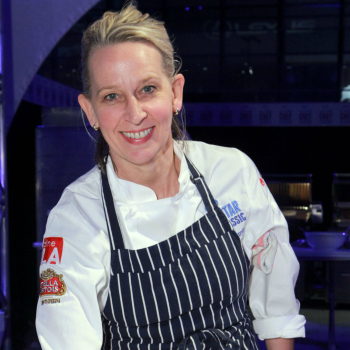For 15 years, Gabrielle Hamilton has been the chef and owner of Prune, one of the most celebrated and idiosyncratic restaurants in New York City. Her bestselling memoir “Blood Bones and Butter” won a James Beard award for best food writing (click here to listen to our interview with her about it, back in 2011). And this month she released her first cookbook, “Prune,” which, in addition to gorgeous photos of her restaurant and her food, contains annotated versions of the recipes she gives her line cooks. They range from fiendishly complex… to surprisingly humble.

Rico Gagliano: The first recipe in the cookbook is canned sardines on Triscuit crackers. The main instruction being to avoid arranging the sardines on the plate in a “restaurant-y” way. Now I should say it sounds delicious, and I’ve actually been craving it since reading the book… but why does that recipe belong in the cookbook and the restaurant of an award-winning chef?
Gabrielle Hamilton: It’s funny because it’s not an irony at all. I don’t have an ironic bone in my body. Cynical and jaded, yes, in certain ways, but I’m kind of the last of the earnest people. And that recipe — if you want to call it that, “open a can of sardines” — I lived on sardines through some very starving times. I was in New York City, I was living out of a jar of change, I was 16 years old, and that was 35 cents at the bodega. So it means a lot to me. And now I find it very delicious and it’s the greatest source of protein! So it’s not a joke, or an affectation, like PBR, that kind of thing that people do.
The other thing is,
I’m trying hard not to have a “restaurant-y” restaurant.So I often have to ask the cooks to make the food look “normal” and not “gasp-able.” I don’t want the food to go down and you have to sort of stop your conversation for 15 minutes to admire what I’ve done. I want the food to look just good enough that it’s appetizing and appealing, and no more. Not intrusive.
Rico Gagliano: First of all, I agree with all of that, and I’m sincere in saying that I really want to eat it right now.
Gabrielle Hamilton: You’re earnest, too!
Rico Gagliano: I am absolutely earnest about sardines, as anyone who has heard this show knows. But this recipe does call into question the idea of what makes something “fine dining.” What, in your opinion, is the key? What separates this from what we do at home?
Gabrielle Hamilton: Well, you know for sure, Prune has no ambition toward fine dining and couldn’t possibly be categorized as fine dining. We have wobbly tables and all the coffee cups are chipped.
We are excellent dining, we are delicious dining, but we are not fine dining.But if you dig into that book or you come into Prune, you know that we also do things that are 37 steps long. Not everything is just popping open a can!
Rico Gagliano: Oh, yeah! For sure!
Gabrielle Hamilton: But the food at Prune is very personal. It’s food that I know very intimately from a lifetime of being up close to it or having eaten it at an originating source. I don’t make anything on the menu that was learned in a stainless steel kitchen or… conceived in a dream. If I’m roasting lamb, it’s because we grew up roasting lamb. If I’m opening a can of sardines, it’s because I survived on eating sardines.
Rico Gagliano: The restaurant, and the book, it’s kind of you. It’s really your personality and the things that you like. To what extent were you surprised at the success of Prune? Does it surprise you that there are so many people that are willing to follow you on that trip?
Gabrielle Hamilton: Eventually that became normal to me, but of course, in the beginning, I was very shocked and surprised when anyone walked in the door. I would always light up with confusion. Like, “Wow! What are you doing here?”
Rico Gagliano: Did you find anything in common with those people beyond their food tastes?
Gabrielle Hamilton: Well, I think that’s actually what happens. I’m not even really sure Prune is a restaurant. It’s really just a litmus test of a universe: Do we all want to live in this particular universe?
Rico Gagliano: Interesting. It’s like a community-builder.
Gabrielle Hamilton: Yes. In a strange way. In a very disparate way. It always amazes me when I look out at the dining room and I see an over-70 year old couple, highly polished and groomed, on their way to the theater, and sitting next to them is some pieced and tattooed lesbian couple with blue hair and body odor.
Rico Gagliano: Is your food the only thing that unites those two people, do you think? Or do you think there is some other kind of trait that they share?
Gabrielle Hamilton: There’s some gestalt there. Something I’ve never been able to name.
It’s sort of the x-factor of restaurant success. You can have the right food, the right lighting, the pretty girl at the door, the good wine list, etc, and you can just tank. But there is that little intangible, I don’t know what it is, but we’re 15 years old — it’s definitely in Prune.
Rico Gagliano: You mention that you’ve been around for 15 years. Increasingly something I’ve been thinking about, particularly in New York City, is that so many bastions and standbys have been closing. What keeps Prune open?
Gabrielle Hamilton: Yeah, 15 years. That’s like 244 in restaurant years, I guess.
Rico Gagliano: These days, probably more.
Gabrielle Hamilton: Yeah! We’re small, and we’re consistent. I think, if you have looked at the cookbook, it could be said that I’m a little “scolding” in the instructions. That there’s a lot of “admonishments” — I think that’s another word that’s been used — if you look at my comments in the book. But I think
inconsistency is the surest death knell of a restaurant. I think you can be consistently terrible and stay in business sooner than you can be inconsistent in your quality.The whole point of haranguing line cooks is because I need the girl who cooks it on Friday to cook it the same as the guy who cooks it on Tuesday. All those recipes are written in a way to keep the product exactly like what we want, year in, year out.
Rico Gagliano: That kind of answers a paradox that I saw in some of these recipes, too. Like, the second recipe in this book is basically radishes with butter and salt. But you say, first of all, that you have seen plates of that go out to diners in a way that you don’t like the way it looks, even though it’s just radishes, butter and salt — that’s all it is. It’s very un-fussy food, in some ways, that is prepared exceedingly fussily.
Gabrielle Hamilton: I know! It’s only three ingredients, but I want my radish quite crisp with burn… and I want my butter cool and waxy… and I want the salt on there at the end to kind of bring back the flame from the radish that the butter tamped down and tamed.
Rico Gagliano: I can tell this is why you won a James Beard award for your writing as well: I would not have ever used the word “flame” to describe a radish. To me, it’s like the opposite, a cooling disc of refreshment.
Gabrielle Hamilton: Oh — you’re eating the wrong radishes!
Rico Gagliano: There you go! I should be eating at Prune more often.
You were known for a long time for helping to popularize bone marrow as a dish. My understanding is one of the reasons that you got into bone marrow in the first place was practical. It’s cheap, you could sell it expensively, and it would kind of underwrite a cheaper steak on the menu, something like that.
Gabrielle Hamilton: It’s true! The poor marrow bone, which my butcher used to give to me for free, now is… I don’t know… $3.25 a pound or something. This whole nose-to-tail eating fiendishness, this trend, is so funny because I think now it has become nose and tail only. I’m, like, “Whatever happened to the pork chop? The poor loin has been left behind!”
Rico Gagliano: “Gimmie a filet, for god’s sake!” I guess my question is, what is the next bone marrow? What is the cheap, under-used ingredient that’s also excellent?
Gabrielle Hamilton: Well, if you just leaf through the “Garbage” section of the cookbook– of things which usually get thrown away — you’re going to start to throw away the sardine just to get the skeleton, just to have the spine, so you can deep-fry it and have the fries. I mean, I’m not really predicting a new trend, I’m just making a joke, but sometimes the thing you were throwing away becomes the thing you most desire.


